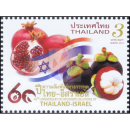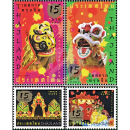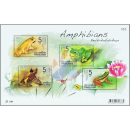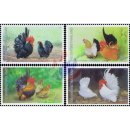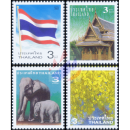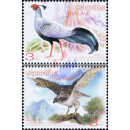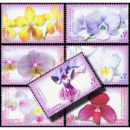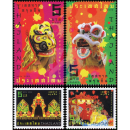Description
Odr. and Laquerfoil (2x5); A = perf. K 14:14 1/2; C = per. K 13 1/4
Set, Issue date: 07/10/2014
Picture descriptions:
ekn-ekr) Thai Amphibians
ekn) Flat-headed Toad (ingerophrynus macrotis / Boulenger, 1887)
eko) Phongsaly Tree Frog (Rhacophorus kio / Ohler and Delorme, 2006)
ekp) Long Nosed Horned Frog (Megophrys nasuta / Schlegel, 1858)
ekr) Red Eared Frog (hylarana erythraea / Schlegel, 1837)
3429 A 5 B multicolored ekn
3430 A 5 B multicolored eko
3431 A 5 B multicolored ekp
3432 A 5 B multicolored ekr
Designer: Miss Mayuree Narknisorn (Thailand Post Company Limited)
Printer: Thai British Security Printing, Bangkok
Quantity: 500,000 pieces
Conservation status:
Here as "MINT NEVER HINGED (MNH)" set
Issue Notice:
- Flat-headed Toad: Native to Western, and Southern Thailand. It is about 5.5 cm tall
- Phongsaly Tree Frog: Rhacophorus kio is an arboreal species that has been recorded from primary and secondary evergreen rainforests with a closed canopy, generally at low elevations. IUCN has classified it as a vulnerable species because of its fragmented distribution and threats from habitat loss
- Long Nosed Horned Frog: Megophrys nasuta is an animal perfectly designed to fit its surroundings. They are attractive however modestly colored. Hidden dorsally in grays, tans, russets, or browns which become darker laterally, they are almost invisible among the forest leaf litter (Bartlett 1996). Their smooth skin is modified so that they resemble dead leaves on the forest floor. A huge angular head with supraciliary projections above each eye and nasal area, along with its cryptic coloration cause it to resemble dry leaves.
- Red Eared Frog: His home is South East Asia, here only six to eight inches tall expectant, metallic green colored frog lives on the edge of the waters. Although he, like the tree frog adhesive discs on the feet has he looks more like a frog pond. With its beautiful green color and a cream-colored, dark-limited line on both sides of the body, he is one of the finest Southeast Asian frogs. It takes its name from the red-colored eardrum

